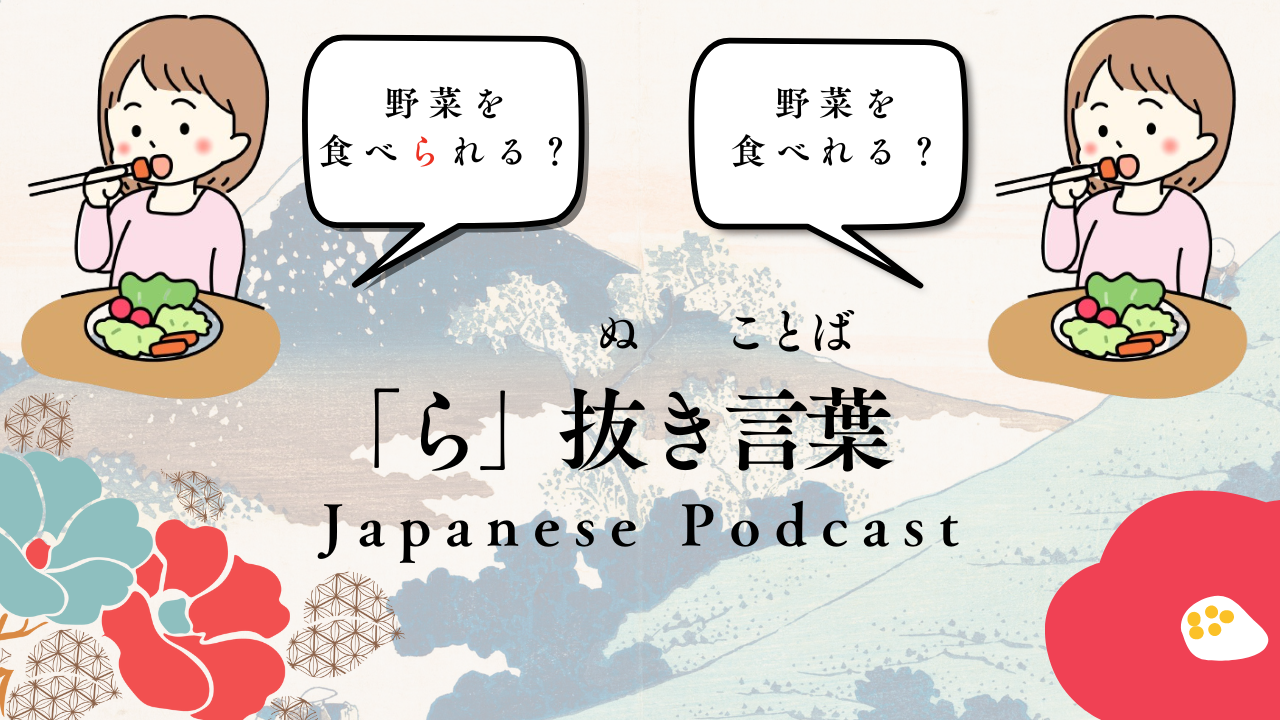Script(Japanese)
*If you want to see Hiragana please watch my YouTube
みなさんこんにちは、みきこです。
今日で12回目の配信となります。
みなさんからの「いいね」「コメント」「チャンネル登録」は更新の励みになっています。
さて、今日のテーマは「ら抜き言葉」についてです。
「ら抜き言葉」とは、可能形の食べれる、寝れる、見れる、来れる・・・などの「れ」の前の「ら」を抜いた言葉のことです。
例えばちょっとこの会話を聞いてください。
今日、飲み会に来れる?
うん、大丈夫!
料理はさしみだけど食べれる?
うん!
この会話を聞いてどうでしょう?
正しくは「来れる」は「来られる」、「食べれる」は「食べられる」ですよね。
でも「ら」が抜けています。
2つとも動詞の可能形ですね。
意味は「来ることができる」と「食べることができる」です。
学生に、「先生、食べますの可能形は、「食べられる」ですか?「食べれる」ですか?」とよく聞かれます。
はい、私が授業の時は「食べられる」って教えているのに、普段の会話になると「食べれる」って使っているからですね・・・
学生はよく聞いていますね。
私はいつも理由を説明して、「食べれる」は、テストではダメですが、日常会話では使ってもいいですよ、と言っています。
あっ、でもこれは人によって考えが違います。
「ら抜き言葉」は正しい日本語じゃないのでよくないと思っている人もいます。
私は言葉は変化していくものだと思っているので、伝わるなら伝わりやすい言葉で伝えた方がいいと思っています。
では、理由を説明しますね。
まず、この「ら抜き言葉」は、2グループの可能形と、3グループの「来る」で起こります。
食べれる、寝れる、見れる、来れる・・・などです。
はい、ではみなさんに質問です。
みなさんこの「食べられる」って言葉を単語だけ聞いて意味がわかりますか?
この単語だけだとわからないですよね。
でも、会話で主語を省略する傾向のある日本語では、「食べられる」だけで話すこともあります。
ですので、「これは可能形?尊敬語?」と混乱を招く恐れがあるのです。
可能形なのか尊敬語なのかを区別するために可能形の時に「ら」を抜いています。
ちゃんとした理由があるので、私的には使ってもいいと思っています。
あっ、でもテストではダメですよー。
それから実はもう一つ理由があります。
それは1グループの動詞の可能形にあるのですが、「遊べる」「書ける」「読める」のように「ら」が入りません。
2グループと3グループの「来る」も「ら」をつけずに変化させた結果が「ら抜き言葉」になったとも言われています。
新しい言葉が生まれたと思ったら古い言葉が消えていったり・・・と、どの国の言葉も変化していると思います。
昔流行って使われていたけど今は使われていない言葉なんかもありますよね。
そんな言葉のことを「死語」と言います。
例えばバブル経済の時に流行った「イタ飯」なんて20代の若者は知らないと思います。
ちなみに「イタ飯」はイタリア料理のことです。
言葉って面白いですね。
はい、今日はここまでです。
最後まで聞いてくれてありがとうございました。
ほなまたね!(じゃあまたね)
Script(Japanese and English)
*The English translation was created by AI.
みなさんこんにちは、みきこです。
Hello everyone, this is Mikiko.
今日で12回目の配信となります。
Today will be the 12th broadcast.
みなさんからの「いいね」「コメント」「チャンネル登録」は更新の励みになっています。
Your likes, comments, and channel registrations encourage us to update.
さて、今日のテーマは「ら抜き言葉」についてです。
Well, today’s theme is about “ra-nuki words”.
「ら抜き言葉」とは、可能形の食べれる、寝れる、見れる、来れる・・・などの「れ」の前の「ら」を抜いた言葉のことです。
“Ra-nuki words” are words that remove the “ra” before the “re” in possible forms such as eating, sleeping, seeing, coming, etc.
例えばちょっとこの会話を聞いてください。
For example, listen to this conversation for a moment.
今日、飲み会に来れる?
”Can you come to the drinking party today?”
うん、大丈夫!
”Yes, it’s okay!”
料理はさしみだけど食べれる?
”The food is sashimi, but can I eat it?”
うん!
”Yes!”
この会話を聞いてどうでしょう?
What do you think after listening to this conversation?
正しくは「来れる」は「来られる」、「食べれる」は「食べられる」ですよね。
Correctly, ”I can come” means ”I can come,” and ”I can eat” means ”I can eat.”
でも「ら」が抜けています。
But “ra” is missing.
2つとも動詞の可能形ですね。
Both are possible forms of the verb.
意味は「来ることができる」と「食べることができる」です。
The meanings are “can come” and “can eat”.
学生に、「先生、食べますの可能形は、「食べられる」ですか?「食べれる」ですか?」とよく聞かれます。
Ask the students, ”Teacher, is the possible form of ”eat” ”edible”? Is it “edible”? ” is often asked.
はい、私が授業の時は「食べられる」って教えているのに、普段の会話になると「食べれる」って使っているからですね・・・
Yes, it’s because even though I teach “edible” in class, in everyday conversation I use “eatable”…
学生はよく聞いていますね。
students often listen to it.
私はいつも理由を説明して、「食べれる」は、テストではダメですが、日常会話では使ってもいいですよ、と言っています。
I always explain the reason and say that although ”edible” is not allowed in tests, it is okay to use it in everyday conversation.
あっ、でもこれは人によって考えが違います。
Ah, but different people have different opinions on this.
「ら抜き言葉」は正しい日本語じゃないのでよくないと思っている人もいます。
Some people think that “ra-nukigoto” is not correct Japanese, so it is not good.
私は言葉は変化していくものだと思っているので、伝わるなら伝わりやすい言葉で伝えた方がいいと思っています。
I believe that words change, so if you want to get the message across, it’s better to use words that are easy to understand.
では、理由を説明しますね。
Well, let me explain why.
まず、この「ら抜き言葉」は、2グループの可能形と、3グループの「来る」で起こります。
First of all, this ”ra-nuki word” occurs in two groups of possible forms and in three groups of ”kuru.”
食べれる、寝れる、見れる、来れる・・・などです
You can eat, sleep, see, come, etc.
はい、ではみなさんに質問です。
Yes, I have a question for everyone.
みなさんこの「食べられる」って言葉を単語だけ聞いて意味がわかりますか?
Can you understand the meaning of the word “edible” by just hearing the word?
この単語だけだとわからないですよね。
You can’t understand just this word.
でも、会話で主語を省略する傾向のある日本語では、「食べられる」だけで話すこともあります。
However, in Japanese, where there is a tendency to omit the subject in conversation, we sometimes say just ”eatable”.
ですので、「これは可能形?尊敬語?」と混乱を招く恐れがあるのです。
Therefore, there is a risk of confusion, such as “Is this a possible form or an honorific word?”
可能形なのか尊敬語なのかを区別するために可能形の時に「ら」を抜いています。
In order to distinguish whether it is a possible form or an honorific form, the ”ra” is removed from the possible form.
ちゃんとした理由があるので、私的には使ってもいいと思っています。
There’s a good reason for it, so I personally think it’s okay to use it.
あっ、でもテストではダメですよー。
Ah, but it doesn’t work on the test.
それから実はもう一つ理由があります。
Actually, there is another reason.
それは1グループの動詞の可能形にあるのですが、「遊べる」「書ける」「読める」のように「ら」が入りません。
This is in the possible forms of verbs in group 1, such as ”play”, ”write”, and ”read”, which do not include the ”ra” character.
2グループと3グループの「来る」も「ら」をつけずに変化させた結果が「ら抜き言葉」になったとも言われています。
It is said that ”Kuru” in Groups 2 and 3 was also changed without adding ”ra”, resulting in ”ra-nuki words”.
新しい言葉が生まれたと思ったら古い言葉が消えていったり・・・と、どの国の言葉も変化していると思います。
I think the language of every country is changing, like new words being born and old words disappearing.
昔流行って使われていたけど今は使われていない言葉なんかもありますよね。
There are some words that were popular in the past, but are no longer used.
そんな言葉のことを「死語」と言います。
Such words are called “dead words.”
例えばバブル経済の時に流行った「イタ飯」なんて20代の若者は知らないと思います。
For example, I don’t think young people in their 20s know about ”Ita Meshi,” which was popular during the bubble economy.
ちなみに「イタ飯」はイタリア料理のことです。
By the way, “Ita Meshi” is Italian food.
言葉って面白いですね。
Words are interesting.
はい、今日はここまでです。
Yes, that’s all for today.
最後まで聞いてくれてありがとうございました。
Thank you for listening until the end.
ほなまたね!(じゃあまたね)
See you later!
Contact Form
質問や仕事の依頼など問い合わせはこちらからどうぞ。
Feel free to send any questions or job requests through this form.



コメント